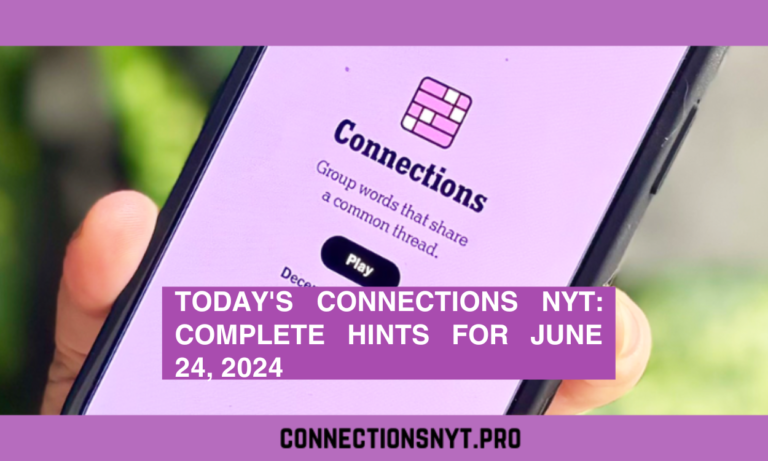5 Top NYT Connections Strategies for Beginners to Become Pros
5 Top NYT Connections Strategies for Beginners to Become Pros 2024.Are you a puzzle enthusiast who’s recently discovered the New York Times Connections game? This addictive word puzzle has taken the internet by storm since its launch in June 2023, captivating thousands of players daily. If you’re a beginner feeling overwhelmed by its unique challenges, fear not! This comprehensive guide will walk you through five top-tier strategies that will transform you from a novice into a Connections pro.
Understanding the NYT Connections Puzzle
Before we dive into the strategies, let’s ensure we’re all on the same page about what the NYT Connections puzzle is and how it works.
What is the NYT Connections Puzzle?
The New York Times Connections is a daily online word puzzle game that debuted on June 12, 2023. Created by puzzlemaker Wyna Liu, it quickly became a sensation among word game aficionados. The game’s popularity skyrocketed, joining the ranks of other NYT puzzle favorites like Wordle, Spelling Bee, and the classic Crossword.
How to Play NYT Connections
The premise of the puzzle is deceptively simple:
- You’re presented with a grid of 16 words or phrases.
- Your task is to group these 16 items into four distinct sets of four.
- Each set of four shares a common theme or connection.
- The challenge? Figuring out what those connections are.
For example, you might see words like “DOG,” “CAT,” “HAMSTER,” and “PARROT” — all of which belong to the category “PETS.” Another group might include “SEDAN,” “SUV,” “COUPE,” and “TRUCK,” which all fit under the “TYPES OF CARS” category.
Difficulty Levels in NYT Connections
One of the game’s unique features is its varying difficulty levels. The four groups are color-coded to indicate their difficulty:
- Yellow (Easiest): The connection is typically straightforward, like types of fruit or basic colors.
- Green (Easy): A bit trickier, but still relatively common categories, like musical instruments or weather terms.
- Blue (Medium): Now we’re getting challenging. These might be more obscure categories or require lateral thinking.
- Purple (Hardest): The toughest of the bunch. Purple groups often involve wordplay, puns, or highly specialized knowledge.
The Stakes: Streaks and Scores
Like many NYT games, Connections tracks your daily performance and maintains a streak count. You have a limited number of mistakes (usually around 4) before you lose. Get all four groups correct, and you maintain your streak. This adds an extra layer of tension and reward, motivating players to keep their winning streak alive.
Why is NYT Connections So Popular?
The puzzle’s rapid rise to fame isn’t a fluke. Several factors contribute to its widespread appeal:
- Simplicity: The rules are easy to grasp, making it accessible to anyone.
- Challenge: Despite simple rules, the puzzles can be fiendishly difficult.
- Variety: With new puzzles daily and varying difficulty levels, it never gets stale.
- Social Aspect: People love sharing their scores and discussing solutions online.
- Brain Exercise: It engages multiple cognitive skills like pattern recognition and lateral thinking.
Now that we’ve covered the basics, let’s move on to the strategies that will elevate your Connections game from beginner to pro level.
Strategy 1: Master the Art of Word Association
The heart of the NYT Connections puzzle is word association. Your ability to see links between seemingly unrelated words will make or break your game. This skill isn’t just about having a vast vocabulary; it’s about understanding the myriad ways words can be related.
Types of Word Associations
- Semantic: Words that share a meaning or category.
- Example: APPLE, BANANA, ORANGE, GRAPE (Category: Fruits)
- Pro Tip: Always start by looking for these basic categories. They’re often the Yellow or Green groups.
- Functional: Words that serve a similar purpose.
- Example: ERASER, WHITEOUT, BACKSPACE, UNDO (Function: Correcting mistakes)
- Pro Tip: Think about what each item does, not just what it is.
- Part-Whole: One word is part of another’s definition.
- Example: SEED, PULP, RIND, JUICE (Part of: Citrus fruits)
- Pro Tip: Great for food items, anatomy, or mechanical parts.
- Synonyms: Words with similar meanings.
- Example: HUGE, GIANT, MASSIVE, ENORMOUS
- Pro Tip: These are rare in easier levels but common in Blue and Purple.
- Antonyms: Words with opposite meanings.
- Example: HOT, COLD, HIGH, LOW
- Pro Tip: The game occasionally uses this twist, especially in harder levels.
- Idiomatic: Words that often appear together in phrases.
- Example: ROCK, PAPER, SCISSORS, SHOOT (Phrase: Rock, Paper, Scissors, Shoot!)
- Pro Tip: A favorite for Purple groups. Think sayings, game names, or famous quotes.
- Cultural: Words related by cultural context.
- Example: OSCAR, EMMY, TONY, GRAMMY (Context: Major entertainment awards)
- Pro Tip: Stay updated on pop culture, history, and current events.

Building Your Association Muscle
- Read Widely: Expose yourself to various topics in books, news, and magazines.
- Play Word Games: Engage in crosswords, word searches, and even word-association party games.
- Use a Thesaurus: Not just for synonyms, but to see how words relate.
- Mind Map: Draw word webs on paper, connecting related terms.
- Daily Practice: Do word-association exercises every day.
Real-Life Application: The Food Web
Let’s apply this to a hypothetical Connections puzzle focused on food:
- CRUST, CHEESE, SAUCE, TOPPINGS
- PATTY, BUN, LETTUCE, PICKLES
- NOODLES, BROTH, PORK, BAMBOO
- RICE, SEAWEED, FISH, WASABI
Can you spot the connections? Here’s how a pro would approach it:
- CRUST, CHEESE, SAUCE, TOPPINGS (Pizza components)
- PATTY, BUN, LETTUCE, PICKLES (Burger ingredients)
- NOODLES, BROTH, PORK, BAMBOO (Ramen elements)
- RICE, SEAWEED, FISH, WASABI (Sushi components)
Notice how each group represents parts of a specific dish. This “part-whole” relationship is key. By mastering various types of word associations, you’ll start seeing these connections instantly.
Strategy 2: Harness the Power of Lateral Thinking
While word association forms the foundation, lateral thinking is your secret weapon for cracking the tougher Blue and Purple groups in NYT Connections. Coined by Edward de Bono in 1967, lateral thinking involves solving problems through indirect, creative approaches.
What is Lateral Thinking?
- Traditional (Vertical) Thinking: Logical, step-by-step, like climbing a ladder.
- Lateral Thinking: Making unexpected connections, like leaping to another ladder.
In Connections, vertical thinking helps with straightforward categories. But for those devious Purple groups? You need to think laterally.
Lateral Thinking Techniques for NYT Connections
- Challenge Assumptions
- Don’t take words at face value.
- Example: RED, CARPET, ZONE, HERRING
- Initial Thought: Colors or sea life?
- Lateral Leap: Idioms! (Red carpet, red zone, red herring)
- Random Entry
- Start with any word, not the “obvious” one.
- Example: STARS, MOON, STRIPES, SUN
- Starting with “obvious” pair STARS & MOON might mislead.
- Start with STRIPES: Could it be STARS & STRIPES (U.S. flag)?
- Indeed: U.S. flag, Union Jack, Japan’s flag, South Korea’s flag.
- Analogy and Metaphor
- See words as symbols for something else.
- Example: APPLE, WINDOWS, BLACKBERRY, AMAZON
- Literal: Fruits and a rainforest?
- Analogical: Tech companies!
- Provocative Questions
- Ask “What if…?” to spark new paths.
- Example: JACK, GIANT, BEANSTALK, GOLDEN
- What if they’re not just random words but part of a story?
- Answer: Elements from “Jack and the Beanstalk.”
- Word Transformation
- Change the word slightly to find connections.
- Example: BITES, BITS, BYTES, BIT
- BITES vs. BITS: Similar sound, different meaning.
- BYTES & BITS: Computer terms.
- BIT: Works in all contexts! (Food bites, small bits, computer bits)
- Focus on Connotations
- Consider emotional or cultural associations.
- Example: OLIVE, DOVE, PIPE, BRANCH
- Literal: No clear link.
- Connotative: All symbols of peace!
Strategy 3: Implement a Systematic Grid Approach
So far, we’ve focused on mental strategies for word association and lateral thinking. Now, let’s talk tactics—specifically, how you visually and systematically approach the NYT Connections grid. A methodical grid strategy can significantly boost your speed and accuracy.
The 4×4 Grid: Your Puzzle Battlefield
When you open a Connections puzzle, you’re faced with a 4×4 grid containing 16 words or phrases. This isn’t just a random arrangement; it’s a battlefield where your strategic moves determine victory or defeat.
- Grid Structure
- 4 Rows, 4 Columns
- Each row/column could be a group, but don’t assume this.
- Words can be read left-to-right or top-to-bottom.
- Psychological Layout
- Easier groups (Yellow, Green) often in outer rows/columns.
- Harder groups (Blue, Purple) frequently in the center.
- This layout encourages you to start easy and work inward.
The Scan-and-Plan Method
- Quick Scan (10 seconds)
- Glance at all 16 words quickly.
- Don’t analyze; just let them sink in.
- This primes your brain for pattern recognition.
- Identify Anchors (30 seconds)
- Look for 2-3 words that clearly go together.
- These are your “anchor pairs.”
- Example: HOBBIT and DWARF (Fantasy races)
- Quadrant Focus (1 minute each)
- Divide grid into 4 quadrants.
- Spend 1 minute on each, clockwise.
- This breaks the puzzle into manageable chunks.
- Bridge Words
- Some words could fit multiple groups.
- Example: STAR could be celestial or Hollywood.
- These “bridge words” are key to harder groups.
- Process of Elimination
- Start with the most obvious group.
- Remove those words mentally.
- The remaining 12 are now your focus.
- Color Code (Optional)
- Use the game’s color-coding feature.
- Yellow for definite matches.
- Blue for maybes.
- This visual aid helps track progress.

Strategy 4: Build and Leverage a Mental Database
In the world of NYT Connections, knowledge is power. The broader and deeper your understanding of various topics, the more connections you’ll be able to make. However, it’s not just about knowing facts; it’s about organizing that knowledge into a structured mental database that you can quickly query during gameplay.
The Importance of Wide-Ranging Knowledge
- Diversity of Topics
- Literature: Genres, authors, characters, quotes
- Science: Elements, laws, scientists, discoveries
- Pop Culture: Movies, TV shows, celebrities, memes
- History: Events, figures, eras, documents
- Sports: Teams, athletes, tournaments, positions
- Food: Cuisines, dishes, ingredients, techniques
- Depth Within Topics
- Example: Shakespeare
- Plays: Romeo & Juliet, Hamlet, Macbeth
- Characters: Mercutio, Puck, Lady Macbeth
- Phrases: “To be or not to be,” “Star-crossed lovers”
- Themes: Love, ambition, jealousy
- Cross-Disciplinary Links
- NEWTON, GALILEO, APPLE, GRAVITY
- Physics: Newton’s laws, gravity
- History: Scientific Revolution
- Folklore: Apple falling on Newton’s head
Building Your Database
- Read Wikipedia’s Featured Article Daily
- Covers diverse topics in depth
- Note key terms and concepts
- Follow Trivia Accounts
- Twitter: @UberFacts, @8factapp
- Reddit: r/todayilearned, r/triviacrack
- Watch Educational YouTube
- Crash Course series
- VSauce, SciShow, Extra History
- Play Trivia Games
- Trivial Pursuit
- QuizUp app
- Pub quiz nights
- Themed Learning Months
- January: World Geography
- February: Black History
- March: Women in Science
- Rotate topics monthly
- News Site Sections
- NYT Arts, WSJ Tech, ESPN
- Read sections you usually skip
- Academic Journals’ “News & Views”
- Nature, Science, The Lancet
- Accessible summaries of new research
Real-Time Database Queries
- Topic Scanning
- First 5 seconds: Identify broad topics
- Food? History? Pop culture?
- Mental “Ctrl+F”
- Search your mind as you would a document
- “Greek Mythology terms…”
- “Baseball positions…”
- Association Chains
- Start with one word, follow links
- APOLLO → Greek god → Sun → Stars → Constellations
- Multiple Queries
- Run 2-3 searches simultaneously
- Group A: Food-related
- Group B: Geography terms
- Compare results
- Incomplete Data Handling
- Recognize 3/4 in Shakespeare group
- Your database suggests: “Needs a PROFESSION.”
- Scan for: NURSE, FRIAR, SERVANT
- “Error 404” Protocol
- Term not found? Don’t panic.
- Use word’s structure for clues
- Sounds French? Try cuisine or fashion.
- All caps? Maybe an acronym.
Strategy 5: Embrace Failure as a Learning Tool
In most games, failure is a setback. In NYT Connections, it’s your most powerful teacher. The game’s design, which allows several mistakes before a loss, isn’t just a kindness—it’s an intentional learning mechanism. Top players don’t just tolerate failures; they actively use them to level up.
The Psychology of Productive Failure
- Growth Mindset
- Fixed Mindset: “I’m bad at this.”
- Growth Mindset: “I’m learning from this.”
- See each mistake as skill-building.
- Comfort with Discomfort
- Easy puzzles don’t teach much.
- Discomfort signals stretching your abilities.
- Top players seek this “productive struggle.”
- Neuroplasticity
- Brain changes through challenges.
- Errors forge new neural pathways.
- Like muscle tears leading to growth.
- Emotional Resilience
- Frustration → Learning → Satisfaction
- This cycle builds mental toughness.
- Applies beyond the game.
Learning from Wrong Answers
- Screenshot Fails
- Before hitting “submit,” screenshot.
- Review wrong groupings later.
- Note patterns in mistakes.
- Error Taxonomy
- Categorize your mistakes:
- Word Misinterpretation
- Overlooked Connection
- Distracted by Red Herrings
- Over-Thinking Simple Groups
- The “Almost Right” Gold Mine
- 3/4 correct groups teach most.
- Example: HEART, CLUB, DIAMOND, DECK
- You picked: HEART, CLUB, DIAMOND, SPADE
- Learned: It’s CARD SUITS, not card-related terms.
- Wrong Answer Word Webs
- List all incorrect groupings.
- Draw connections you saw.
- This maps your thought process.
- Time-Location Analysis
- Note when errors occur.
- Early game: Rethink openings.
- Last group: Work on endgame pressure.
- Alternate Solutions Workshop
- Post fails online.
- Ask: “What did you see?”
- Learn others’ perspectives.
Strategic Risk-Taking
- The “3 Free Mistakes” Rule
- Game allows about 3 errors.
- Use them strategically.
- Not a safety net, but a tool.
- Educated Guesses
- 75% sure? Submit it.
- Right: Great!
- Wrong: More informative than staring.
- A/B Testing
- Two plausible groupings?
- Submit one, note result.
- Rethink based on feedback.
- Purple-First Approach
- Start with hardest group.
- Use mistakes to unlock it.
- Once solved, easier ones fall into place.
- Time-Pressure Simulation
- Set 1-minute rounds.
- Prioritize speed over accuracy.
- Analyze rushed mistakes.
- The “Hail Mary” Play
- Down to last try?
- Make a bold, unconventional guess.
- Often, “crazy” ideas are breakthrough ones.
Conclusion:
Mastering “NYT Connections” can transform a beginner into a pro by following effective strategies. By familiarizing yourself with common patterns, practicing regularly, analyzing your mistakes, utilizing available resources, and engaging with the community, you can significantly enhance your skills. Remember, consistency and a willingness to learn are key to success. With dedication and the right approach, you’ll be navigating “NYT Connections” with the expertise of a seasoned pro in no time.
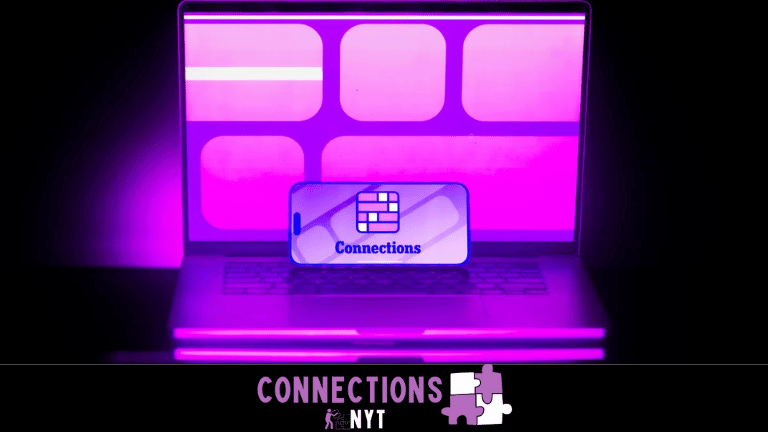
FAQs
What is NYT Connections?
“NYT Connections” is a puzzle game by The New York Times that challenges players to find hidden connections among seemingly unrelated words or concepts.
Why should beginners use specific strategies for NYT Connections?
Using strategies helps beginners identify patterns and improve their problem-solving skills, leading to faster and more accurate solutions over time.
What are common patterns to look for in NYT Connections?
Common patterns include word associations, thematic links, synonyms, antonyms, and category-based connections such as colors, animals, or historical events.
How can I practice NYT Connections effectively?
Regular practice is crucial. Start with easier puzzles, gradually increasing the difficulty as you become more comfortable. Utilize online puzzle archives and apps to practice consistently.
How can analyzing mistakes improve my game?
Reviewing incorrect answers helps you understand where you went wrong, refine your strategies, and avoid similar mistakes in the future, leading to continuous improvement.
How can engaging with the community benefit my gameplay?
Engaging with the community allows you to exchange ideas, learn new strategies, and receive feedback from experienced players, fostering a collaborative learning environment.
What should I do if I get stuck on a puzzle?
Take a break and return with a fresh perspective, or seek hints and tips from online resources or community forums to help you overcome challenging puzzles.


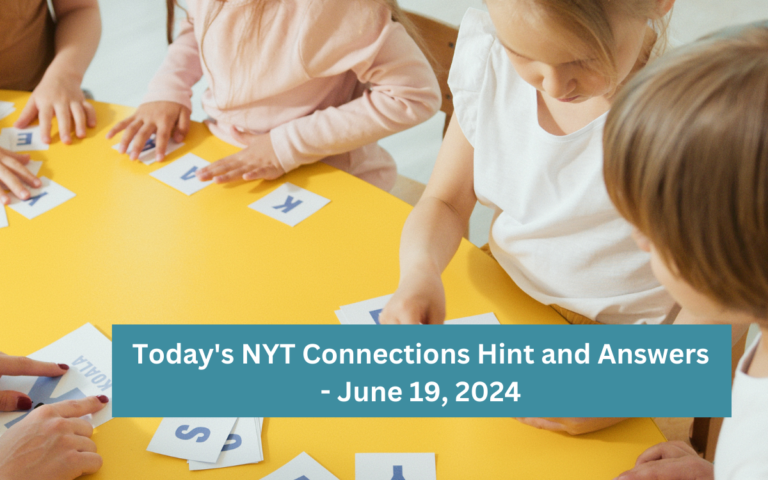

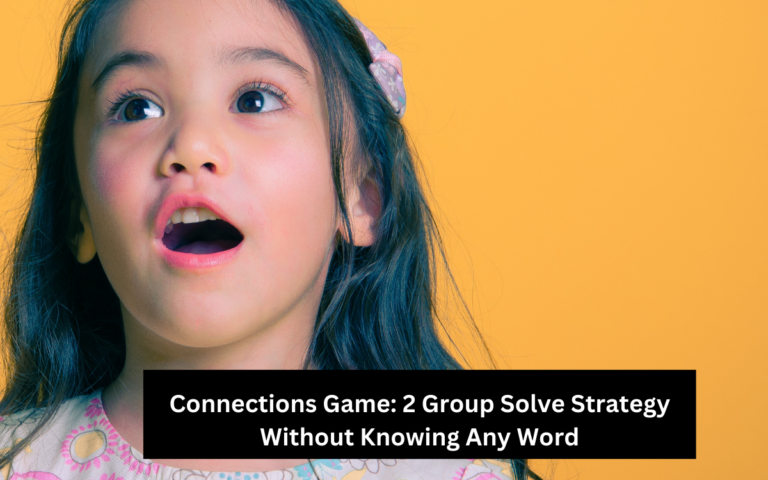
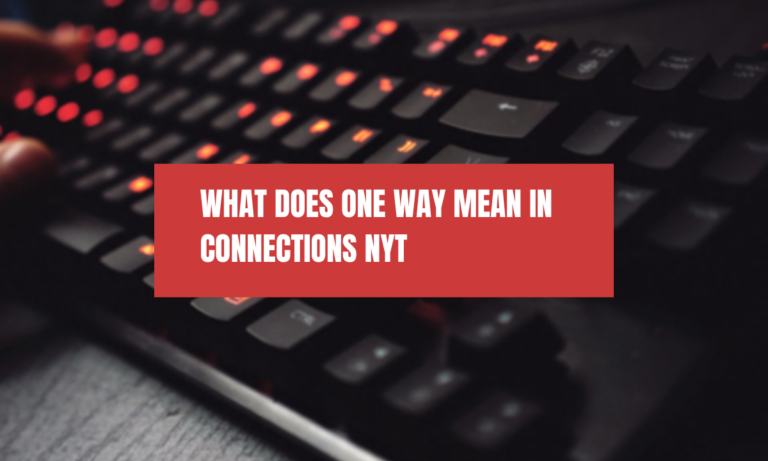
![“Connections”: The Story of a Four Word Four Groups Game [2024]](https://connectionsnyt.pro/wp-content/uploads/2024/06/Connections-NYT-Ranked-Best-Educational-Game-For-2024-24-768x480.png)
